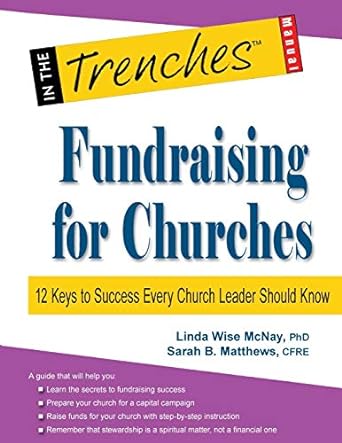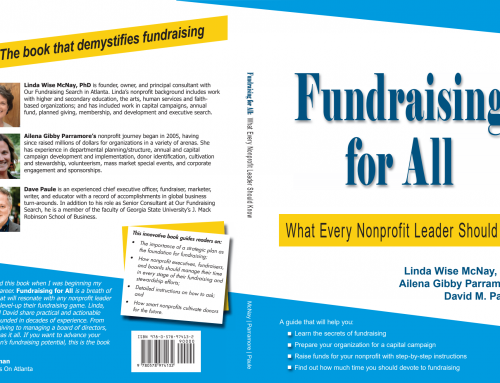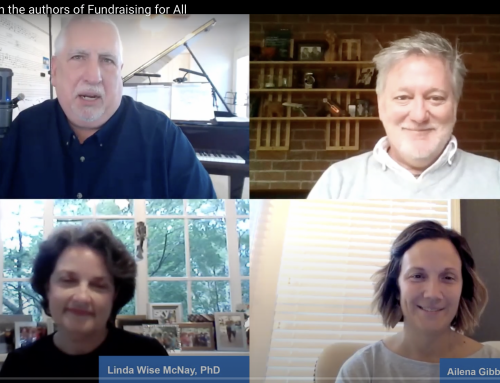
Fundraising for Churches: 12 Keys to Success Every Church Leader Should Know
FOREWORD By: The late Jerold Panas
Author, Speaker, Former Executive Partner, Jerold Panas, Linzy & Partners
If your church would benefit from additional funds (and what church wouldn’t), you have precisely the right book in your hands – Fundraising for Churches. Every clergy, every church leader, every member of a church board should have a copy.
To my way of thinking, the book is the very best in its field. The subtitle is: “Twelve Keys to Success Every Church Leader Should Know.” It’s all there. There’s everything you would want to know about annual operating support, capital campaigns, and endowment for building and maintenance.
It’s wonderfully written. I found myself finishing it in one sitting. Then rereading it, underlining and writing in the margins.
The authors, Sarah Matthews and Linda McNay, tell us in an early paragraph, “You will have a clear understanding of how to raise meaningful dollars, and you will have the confidence to launch a highly ambitious and successful fundraising campaign.” They deliver on that promise.
Here’s what I particularly like about the book. You will, also. I’m reminded that it’s not really about money. It’s about the human spirit. Dreams. And high aspirations.
I’m positive that if you emphasize the spiritual life of the Church, the money will follow.
When I first saw the title, I wasn’t enthralled. Well, that’s the truth of it. I thought it ought to have more zip, more snap, crackle and pop.
But actually the title says something about the book. It’s basic, fundamental, pure fundraising. There’s not a lot of philosophy. Just the essential nuts and bolts of raising funds. From A to Z.
For instance, they answer the question about how much a parishioner should contribute to a Church. And whether clergy should know what members of the congregation give. I’ve wrestled with those questions myself.
You will also read about why one church returned a valuable Picasso. I kept thinking as I read the passage, “Don’t return the painting. Find a way to keep it.”
I have found that people do not want to just give money away, they want to give to programs and causes that touch lives in magical ways. The authors make it quite clear that people will give, generously and sacrificially, when the need is clearly and passionately demonstrated.
We are reminded that God is the giver, the true donor. The job of the Christian is not to begrudgingly discern how much should be given away, but to make certain of the reality that God is the donor. I love a little poem I have saved and used over the years:
Angel, must I give again, I ask in dismay,
And must I keep giving and giving and giving it away?
Oh no, said the Angel, his glance pierced me through,
Just keep giving till the Lord stops giving to you.
The book presents a very strong case for tithing. There are seven scripture references that have a stewardship-theme. I went back to my Bible and read each one. This was powerful. Interestingly, there are 67 references to tithing in the Bible.
There is an outline for what should be included in all the details of a campaign. It is priceless. Along with it, a chart of the suggested hierarchy of the campaign. There’s even a lesson on who should chair the program.
I had one small quarrel. But it’s really a minor issue. There’s reference in the book that people give to people. That’s a hoary verity in our profession – that people give to people. It’s been repeated ad nauseum.
Actually, people don’t give to people. I believe what is meant is that people give more when they are asked in person. People don’t give to people – they give to exciting, important, spiritual causes.
The book also deals with the importance of one-on-one personal solicitations. We know you don’t get milk from a cow by sending a letter. And you don’t get milk from a cow by calling on a phone. You get milk by sitting next to the cow and milking it.
There is a superb section on how to get the appointment. My experience is if you get the appointment, you’re 85% on your way to getting the gift. The authors tell us how to ask for the gift, what you do when you arrive for the meeting, and what should be said to get the gift.
And they tell you how you respond to, “I’ll need to think about it.” Or what do you do if there are objections. The book answers all of this. I can tell you that when you finish this section, you are indeed ready to ask.
The chapter on capital campaigns is as good as I’ve ever read. It takes you from the planning to the feasibility study, to the Case, to the ask. Follow this and you are assured of success.
There’s some good news I want to share with you. The authors report that it’s clear that a capital campaign does not affect annual giving. Quite the contrary, it helps increase it. That’s been my experience, also.
Every Church leader, in fact every member of the Church, should read the section on endowment. That’s the future of your Church. Planned giving and bequests should be stressed throughout the year with congregants.
You read that people who make large gifts generally do not make quick decisions. They’ll need a little cultivation. I remind you that you don’t make a pickle by sprinkling a little vinegar over a cucumber! You have to immerse it.
The larger the gift, the more likely it is to be emotional. Large gifts are visceral, not cerebral.
I’ve faced the question of what do you do with members who have not turned in their pledge card. This can be awkward. This book has the answer.
There’s a wonderful schedule for how to prepare for a Fall pledge drive. I’ve looked it over. It is fail-proof. If you follow that, you simply can’t miss.
To my way of thinking, one of the very best sections is on stewardship. The ultimate goal for the Church is to develop disciples and to support them as they grow. This takes time.
I could go on and on. The book is wonderfully easy to read and packed to the brim and overflowing with powerful and helpful information.
This book doesn’t belong in the Church Library. It belongs on every Pastor’s desk. And in the hands of every church leader.
Fundraising for Churches is one of those rare books that takes you by the hand and truly leads you to successful fundraising.




Leave A Comment